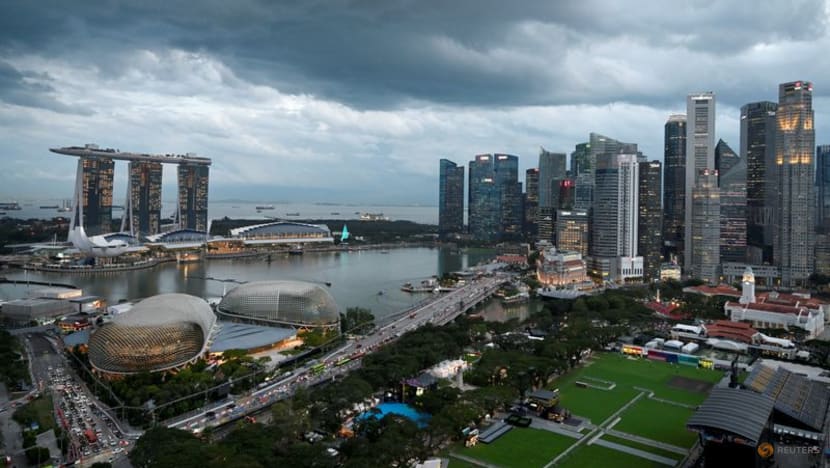Singapore maintains 2025 growth forecast at 0-2%; economy grew 3.9% in Q1
The Ministry of Trade and Industry cautioned that the global economic outlook “remains clouded by significant uncertainty”.

A view of the Singapore skyline on Sep 17, 2024. (File photo: Reuters/Caroline Chia)

This audio is generated by an AI tool.
SINGAPORE: Singapore has maintained its growth forecast for the year at a range of 0 to 2 per cent, even as data on Thursday (May 22) showed the economy grew slightly faster than expected in the first quarter of 2025.
While the external demand outlook for the rest of the year has “improved slightly” following recent tariff talks, the Ministry of Trade and Industry (MTI) sounded caution about an uncertain environment ahead.
“Given the heightened uncertainty, MTI will continue to monitor developments closely and make adjustments to the forecast as necessary in the coming quarters,” said MTI’s Permanent Secretary Beh Swan Gin at a press conference.
The Singapore economy grew by 3.9 per cent on a year-on-year basis in the first quarter, just above the government’s advance estimates of 3.8 per cent. Still, this is a slowdown from a 5 per cent growth in the fourth quarter of 2024.
On a quarter-on-quarter seasonally adjusted basis, the Singapore economy contracted by 0.6 per cent, better than the prediction of a 0.8 per cent contraction, but reversing from a 0.5 per cent growth in the previous quarter.
In its press release, MTI said first-quarter gross domestic product (GDP) growth was largely driven by the wholesale trade, manufacturing, as well as finance and insurance sectors.
In particular, growth in the manufacturing and wholesale trade sectors was likely to have been partly supported by front-loading activities ahead of anticipated tariff hikes by the United States.
“SIGNIFICANT UNCERTAINTY” AHEAD
The government had in April downgraded Singapore’s GDP growth forecast on the back of a “significant deterioration” in the country’s external demand outlook due to the sweeping tariffs announced by US President Donald Trump.
Since then, the US and several economies have embarked on trade negotiations. Notably, the US and China have agreed to reduce the tariffs imposed on each other for 90 days while they negotiate a trade deal, MTI said.
“Given the steps taken by major economies to de-escalate global trade tensions, MTI’s assessment is that Singapore’s external demand outlook for the rest of the year has improved slightly compared to April,” it said.
In the US, for example, GDP growth is likely to come in slightly better than projected in April, given the 90-day truce in the trade war with China, although growth is still expected to slow for the rest of 2025.
Still, MTI cautioned that the global economic outlook “remains clouded by significant uncertainty”.
This includes elevated economic uncertainty, which may lead to a larger-than-expected pullback in economic activity and the risk of a re-escalation in tariff actions, including retaliatory tariffs, that could lead to a full-blown global trade war.
Against this backdrop, the growth of outward-oriented sectors in Singapore is expected to slow over the course of the year.
US' tariff measures are likely to "adversely affect" the manufacturing sector given its export exposure to the US market, as well as slowing growth in global end-markets. That said, the transport engineering cluster within the sector “remains a bright spot”, especially given the shift towards aircraft maintenance, repair and overhaul works.
MTI said the manufacturing sector’s slowdown, coupled with weaker global trade, will in turn weigh on the trade-related services sectors.
In the wholesale trade sector, sales volumes are expected to weaken as the boost from front-loading activities fades and global trade softens, especially in the second half of 2025.
The projected decline in global trade will similarly negatively affect the transportation and storage sector through a softer demand for shipping and air cargo services.
Meanwhile, growth in the finance and insurance sector could be weighed down by episodes of weaker trading activity, as well as more tepid business activity and lower consumer spending.
The information and communications and professional services sectors could also see muted growth if firms cut back on discretionary spending, such as IT and marketing.
Growth in the consumer-facing sectors, such as retail trade and food and beverage services, is likely to remain lacklustre as locals continue to spend abroad and an expected weakening of domestic labour market conditions.
TECHNICAL RECESSION?
Asked about the possibility of a recession, Dr Beh said a technical recession, meaning two consecutive quarter-on-quarter contractions, is “a possibility” with the contraction seen in the first quarter of the year.
However, “that doesn't necessarily equate to a full-blown economic recession” which depends on year-on-year figures, he added.
The Monetary Authority of Singapore (MAS) said its “measured adjustment” in monetary policy taken in April remains appropriate as of now.
Last month, the central bank reduced “slightly” the rate of appreciation of the Singapore dollar nominal effective exchange rate, easing monetary policy for the second time in a row as economic fears rise due to the trade war brewing between the US and China.
Leading up to its next monetary policy meeting in July, the MAS “will be onboarding all incoming data and making a comprehensive assessment about the appropriateness of policy”, said deputy managing director Edward Robinson.
Separate data released on Thursday showed Singapore’s key exports grew by 3.3 per cent in the first quarter, extending the 2.4 per cent growth in the previous quarter.
Growth in the non-oil domestic exports (NODX) was driven by both electronics and non-electronics, said Enterprise Singapore, adding that it would be maintaining the country’s NODX forecast at a range of 1 to 3 per cent growth.
The lower bound of forecast builds in a weaker second-half outlook amid an evolving tariff situation, said the trade agency.
“Notwithstanding the recent US-China trade tension de-escalation, downside risks could intensify after the 90-day reciprocal tariff reprieve expires.”
OCBC’s chief economist Selena Ling said the better-than-expected growth in NODX could be attributable to front-loading activities sparked by tariff concerns, as seen from a 19.2 per cent year-on-year surge in key exports to the US during the first quarter.
Despite optimism over recent developments, such as a 90-day trade truce between US and China, Ms Ling said her forecast for NODX would range from -1 to 1 per cent to “build some buffer for softer global growth prospects and a potentially bumpy road ahead for tariff agreements”.
“It could well be a story of two halves with front-loading in (the first half), followed by a deceleration in (the second half),” said Ms Ling.
DBS senior economist Chua Han Teng also sees front-loading activities supporting growth in the country’s trade-related sectors in the near term.
“Exporters are likely to capitalise on temporarily lowered US tariffs by front-loading export orders,” said Mr Chua, adding that “this could be sufficient for Singapore’s economy to avoid a technical recession” in the second quarter of the year.
Still, global trade friction remains high, with significant uncertainties lingering over ongoing US tariff negotiations and impending sectoral tariffs.
With that, the Singapore economy could see “much weaker” economic growth in the second half of the year, Mr Chua added.

















